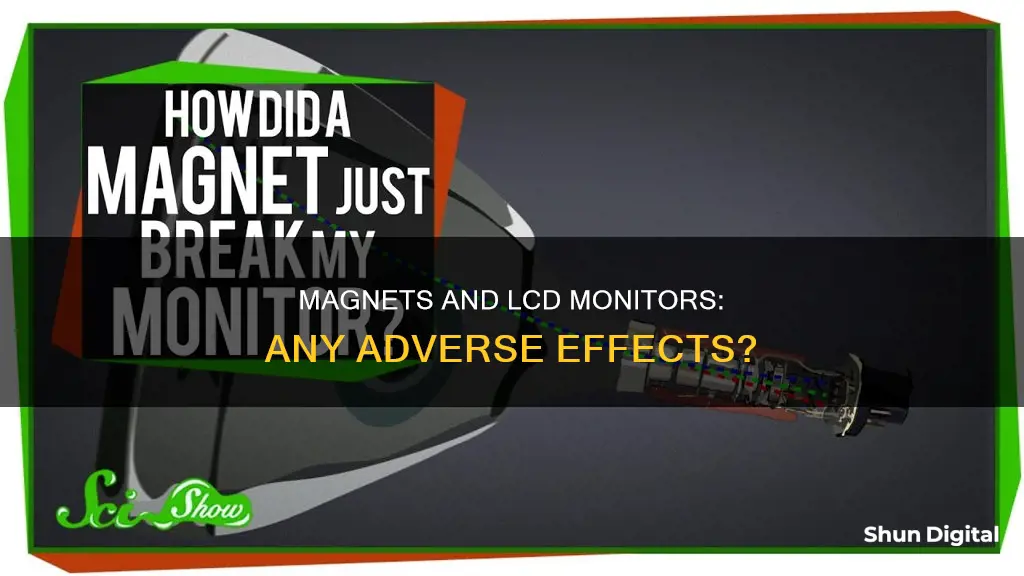
Magnets have long been believed to interfere with electronics, with many people believing that they can wreak havoc on computer monitors and hard drives. While this is true for old floppy drives and CRT monitors, LCD screens are generally not affected by magnets. CRT monitors use magnets to help project the image on the screen, so an external magnet can cause problems. LCD screens, on the other hand, function differently and are not affected by magnetic fields in the same way. While it is generally safe to use magnets around LCD screens, it is still recommended to avoid placing strong magnets directly on top of your devices to avoid any potential damage.
| Characteristics | Values |
|---|---|
| Do magnets affect LCD monitors? | No |
| Why? | LCD monitors function differently from CRT monitors and do not have a beam of electrons to be affected by magnets |
| Are there any exceptions? | Some LCDs and most older LCDs use cold cathode compact fluorescent lamps (CCFL) backlights which magnets could interfere with |
| Can magnets damage a hard drive? | Magnets can damage a hard drive if placed directly on top of it while it's functioning |
What You'll Learn

Magnets and CRT screens
CRT screens, or Cathode Ray Tube screens, project images by shooting electrons at a fine iron-alloy mesh, which then illuminates the screen. The beam of electrons is steered by a set of magnets to paint the screen, line by line, from top to bottom. As electrons have a charge, any magnet near the screen will deflect the beam and cause disruptions on the screen.
However, this does not cause any permanent harm to the screen. But, since the mesh screen is made of iron, a magnet close to the screen can magnetise the iron and even warp the mesh, causing permanent damage to the screen.
In addition, CRT screens can become permanently magnetised, which is why they sometimes need to be de-gaussed.
Android LCD Monitors: Fact or Fiction?
You may want to see also

LCD screens and magnets
CRT monitors used magnets to help project the image on the screen, so an external magnet would cause problems. LCD screens, on the other hand, do not have a beam of electrons to be affected by magnets. In LCD screens, there are no moving electrons, except when the image changes, so there cannot be any effect on a steady display. Any effect during a moving display will be very small and will disappear once the display is steady again.
However, there is a component in some LCD screens that uses electron movement, and this can be affected by magnets. The backlights in some LCDs, especially older models, use cold cathode compact fluorescent lamps (CCFL). These are high-voltage, high-frequency discharge tubes involving electron discharge to generate UV light. Magnets could interfere with this process and potentially damage the screen's operation.
It is worth noting that speakers use magnets to work, and they do not mess with LCD screens. Additionally, iPads and iMacs have magnets surrounding the display, further proving that magnets generally do not affect LCD screens.
Customizing Monitor Backgrounds: Sizing for a Better View
You may want to see also

Hard drives and magnets
Today, hard drives are much more resistant to magnets. To corrupt the data on a hard drive, you would need an extremely powerful magnet—something that most people do not have lying around their homes or offices. These magnets need to have at least 450 pounds of force, which eliminates almost all magnets except for some of the strongest neodymium magnets.
Even if you were to obtain such a powerful magnet, it is unlikely that you would be able to corrupt the data on a hard drive. The platters surrounding modern hard drives are made with high coercivity materials, which means they are designed to withstand magnetic force. In fact, the strength of the magnet required to corrupt data is so powerful that it would likely destroy the hard drive and everything else in the room before it had a chance to affect the data.
Additionally, just because a hard drive stops working does not mean that the data has been erased. Unless you have advanced data recovery skills, it would be challenging to determine whether the data has been truly erased or if the hard drive has simply been damaged.
While it is theoretically possible to destroy a hard drive with a magnet, it is not a reliable method. If you are concerned about securely disposing of sensitive data, it is best to consult a professional data destruction service. They can help ensure that your data is permanently and securely destroyed while also complying with any relevant data disposal laws and regulations.
HP V212 Monitor: Know the Exact Dimensions
You may want to see also

Solid-state drives and magnets
Solid-state drives (SSDs) and magnets are not the best of friends, but they are not enemies either. SSDs are based on flash memory, which uses floating-gate transistors to store data, not magnetic charges like hard disk drives (HDDs). So, if you have a strong magnet next to your SSD, your data is likely safe. However, changes in magnetic fields, or magnetic flux, can introduce issues and cause data loss under certain circumstances.
The rate of change in magnetic fields, or magnetic flux, can create small voltages that may travel over electronic circuits and cause damage. This means that a tremendous change in magnetic flux is required to damage an SSD, and even then, it is not a realistic danger. In fact, most round cables are shielded against magnetic interference. So, unless you have an incredibly strong magnet, your SSD should be safe.
While SSDs are generally resistant to magnets, HDDs are a different story. Strong magnetic fields can destroy data on HDDs because they use magnetism to store data. Disrupting those charges will result in data loss. This is why degaussing, a process that applies strong magnetic fields to erase data, is used by professionals to securely wipe HDDs.
In conclusion, while magnets can have a significant impact on HDDs, SSDs are much more resistant due to their use of flash memory. However, it is still recommended to keep strong magnets away from any electronic device, including SSDs, as a precaution.
Designo Monitors: ASUS's Premium Display Lineup Explored
You may want to see also

Magnet strength and screen damage
CRT screens are affected by magnets due to their use of a built-in magnet to control the electrons that create the display. LCD screens, on the other hand, do not contain any built-in magnets and are therefore not affected by external magnets. The liquid pixels of an LCD screen are illuminated with a backlight and do not use electrons to strike their pixels.
While LCD screens are generally not affected by magnets, there is one component in some LCD screens that may be affected by magnets: the backlights. Some LCDs, particularly older models, use cold cathode compact fluorescent lamps (CCFL) for backlighting. These lamps use electron discharge to generate UV light, and it is possible that magnets could interfere with this process and cause damage to the screen's operation. However, the effect of a magnetic field on an LCD/LED monitor is generally unnoticeable, and LCD screens are considered magnet-safe.
It is worth noting that while magnets may not cause damage to LCD screens, they can interfere with other components of electronic devices. For example, magnets can affect the accuracy of digitizers and styluses in certain devices, such as the Samsung Galaxy Note 8.0 tablet. In this case, the presence of a magnet near the screen can cause issues with the S-Pen's accuracy, and long-term use of a magnet on the screen may result in permanent damage to the digitizer technology. Additionally, cables can be affected by magnetic fields if they are not shielded, although the interference is typically minimal.
To summarize, while magnets can affect certain components of electronic devices, LCD screens are generally considered safe from magnet damage. However, it is always a good idea to keep magnets away from electronic devices to avoid any potential issues.
Finding Monitor Size: Pixel Count for Display Settings
You may want to see also
Frequently asked questions
Magnets do not affect LCD monitors. LCD monitors are not influenced by magnets because they function differently from CRT monitors.
LCD monitors do not have a beam of electrons to be affected by magnets.
Magnets do affect CRT monitors. CRT monitors use a beam of electrons to form an image, and magnets interfere with the path of this electron beam.
Magnets can affect hard drives, as they store data magnetically.







